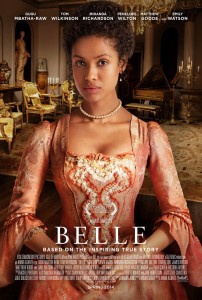I wish I could be sitting in the same room when you watch this movie. Belle has such texture, such fabric, such color. There have been several worthy movies about slavery; so many are based on true stories mainly because there are so many noteworthy true stories to tell. Many of these stories are told from different vantage points. The 17th century England practically dictated that.
Belle is a film with a unique perspective. Very unique.
Born to an African slave mother and an aristocrat father, Dido was reared as nobility… almost. While young, getting a fine private education alongside her fair haired cousin, Dido’s plight was not as apparent. She and Cousin Elizabeth were playmates; more like sisters.
Belle is inspired by the true story of Dido Elizabeth Belle (Gugu Mbatha-Raw), the illegitimate mixed race daughter of Admiral Sir John Lindsay (Matthew Goode). Raised by her aristocratic great-uncle, Lord Mansfield (Tom Wilkenson) and his wife (Emily Watson), Dido’s lineage affords her certain privileges, yet her status prevents her from the traditions of noble social standing. While her cousin, Elizabeth Murray (Sarah Gadon) pursues suitors for marriage, Dido is left on the sidelines wondering if she will ever find love. Let me stop right here and assure you, this is not actually a love story. It just so happens that marrying either for love or any other reason is one of Dido’s challenges of her mixed racial birth.
Elizabeth is quite literally the belle of the ball until the families of her suitors realize she is the “poor” cousin. Now, wealth is relevant but as fate would have it, the real Belle of the Ball was actually the beautiful, exotic Dido. Wealthy but with a race stigma. Intelligent and strong-willed, she has an ambiguity of position—too high to dine with servants, too low to dine with guests. What would it be like to have power, inheritance and property and not be able to marry for love; to be both aristocratic and scorned?
There is a huge backstory here. After meeting an idealistic young vicar’s son, John Davinier, bent on changing society, he and Dido help shape Lord Mansfield’s role as Lord Chief Justice to end slavery in England through a quite controversial court case.
As I mentioned earlier, there is a unique perspective being played out here. Amma Asante, Director of this amazing work who is also black, said this about the painting that inspired Belle. “Around the time of the 18th century, we really were—people of color were—an accessory in a painting. We were there rather like a pet to express the status of the main person in the painting, who was always white. And for anybody who’s lucky enough to see the painting, what you see is something very, very different. You see a biracial girl, a woman of color, who’s painted slightly higher in the painting, depicted slighter higher than her white counterpart. She’s staring directly out at the painter, you know, with a very direct, confident eye…So this painting flipped tradition and everything that the 18th century told us about portraiture. These two girls were aristocrats. What I saw from the painting was this opportunity, if I got it right, to tell a story that would combine art history and politics.”
Like the film, Amazing Grace, Belle is a fascinating history lesson. With all the turmoil in our world today it brings another historical piece of this puzzle to the forefront. I highly recommend this beautiful movie.
I look forward to your comments as usual at chastings@rockcliff.com.
Leave a Reply